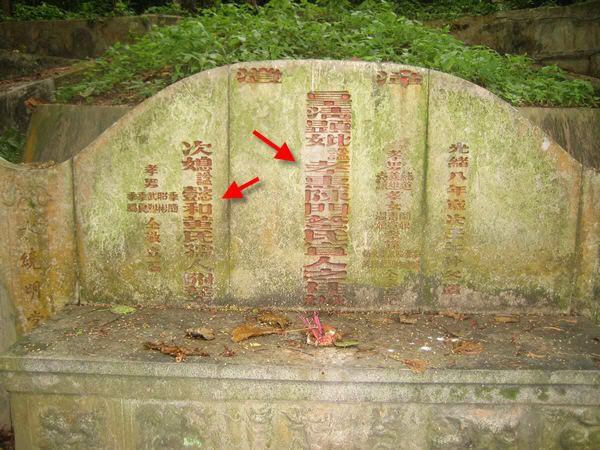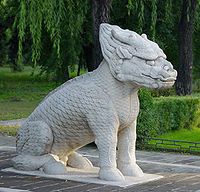Wuying Ho Yi (aka Wong Ho Yi aka Mrs Tan Soon Toh.) my Great Great Grand Mother
Mdm Chua (aka Mrs Tan Kim Ching) My Great Great Great Grand Mother
(Addendum 25 Jan 2014; Raymond Goh Darren Koh,
Thanks for putting a name to the face!
My great great grand mother I have only known as Wuying Yi Ho.
Now I learn Mrs Tan Soon Toh actually name would 織理 Zi Li (posthumous name : Yi Ho).
織理 in cantonese would be jik leih. Weave reasons..
And we learn that Wuing Boon Whatt was buried at Jln Novena and exhumed.)
Mother -in-law and daughter in law
lie side by side in a tomb at outram hill
tomb erected 1882..

There are two female names here.
The name in the centre is the Chua Xiao Hui the wife of Tan Kim Cheng.
Family records her name as Chua Seah Neo (aka Yee Ren aka Ee Jin)
She is the daughter of the descendant of Malacca famous personality Chua Yan Keng.
Chua Yan Keng himself was son of Chua Chong Kiat.
She has 3 sons, the 2nd is Tan Soon Toh (1853 - 1892). 3 daughters, and 7 grandchildren.
The female name on the left is Wong Yi Ho. She is the wife of Tan Soon Toh and is the daughter of lawyer Wong Boon Fah.
(Soon Toh married Wuing Yi Ho, the daughter of Wuing Boon Whatt who according to Song Ong Siang, was the first Chinese in Singapore to practice law) the family name is recorded as "Wuing" Su Min's guess it was a dialect pronunciation.
She has 5 boys listed on the grave. (Tan Soon Toh has a 2nd wife Seow Lin Neo who died in 1926)
There are 3 wells in front of this grave. 2 wells are half wells, meaning half is closed, half is filled with water. The 3rd well is completely closed.

It is believed that the purpose of the half wells is to tap the dragon spirit.
The closed well is to prevent the dragon spirit from escaping.

There are 3 wells in front of this grave. 2 wells are half wells, meaning half is closed, half is filled with water. The 3rd well is completely closed.

It is believed that the purpose of the half wells is to tap the dragon spirit.
The closed well is to prevent the dragon spirit from escaping.

The hill spirit stands as guardian for the tomb
Four Chi-lin flank the forecourt .
The Qilin (Chinese: 麒麟; pinyin: qílín; Wade–Giles: ch'i-lin) is a mythical hooved Chinese chimerical creature known throughout variousEast Asian cultures, and is said to appear with the imminent arrival or passing of a wise sage or an illustrious ruler. It is a good omen that brings rui (Chinese: 瑞; pinyin: ruì; roughly translated as "serenity" or "prosperity"). It is often depicted with what looks like fire all over its body. It is sometimes misleadingly called the "Chinese unicorn" due to conflation with the unicorn by Westerners.
Origins
The earliest references to the Qilin are in the 5th century BC book Zuo Zhuan.The Qilin made appearances in a variety of subsequent Chinese works of history and fiction. The word Qilin is derived from the Somali word Geri, which means Giraffe.
In legend, the Qilin became tiger-like after their disappearance in real life and become a stylised representation of the giraffe in Ming Dynasty. The identification of the Qilin with giraffes began after Zheng He's voyage to East Africa (landing, among other places, in modern-day Somalia). The Ming Dynasty bought Giraffes from the Somali merchants along with Zebras, incense and other various exotic animals. Zheng He's fleet brought back two giraffes to Nanjing, and they were referred to as "Qilins". The Emperor proclaimed the giraffes magical creatures, whose capture signalled the greatness of his power.
The identification between the Qilin and the giraffe is supported by some attributes of the Qilin, including its vegetarian and quiet nature. Its reputed ability to "walk on grass without disturbing it" may be related to the giraffe's long, thin legs. Also the Qilin is described as having antlers like a deer and scales like a dragon or fish; since the giraffe has horn-like "ossicones" on its head and a tessellated coat pattern that looks like scales it is easy to draw an analogy between the two creatures.
It is unlikely that giraffes and Qilin were regarded as the same creature in pre-modern times however. For example, typical depictions of the Qilin have much shorter necks than giraffes.
[edit]Description
There are many different ways Qilin have been described. Some think of them as a rare form of unicorn; others have described it as a creature that has the head of a dragon and a body of tiger with scales. Others see it as a creature with a single horn on its forehead, a multicolored back, the hooves of a horse, the body of a deer, and with the tail of an ox.
Although it looks fearsome, the Qilin only punishes the wicked. It can walk on grass yet not trample the blades, and it can also walk on water. As it is a peaceful creature, its diet does not include flesh. It takes great care when it walks never to harm or tread on any living thing, and it is said to appear only in areas ruled by a wise and benevolent leader (some say even if this area is only a house). It is normally gentle but can become fierce if a pure person is threatened by a sinner, spouting flames from its mouth and exercising other fearsome powers that vary from story to story.
Legends tell that the Qilin has appeared in the garden of the legendary Huangdi and in the capital of Emperor Yao. Both events bore testimony to the benevolent nature of the rulers. It's been told in legends that the birth of the great sage Confucius was foretold by the arrival of a Qilin.
Some stories state that the Qilin is a sacred pet (or familiar) of the deities. Therefore, in the hierarchy of dances performed by the Chinese (Lion Dance, Dragon Dance, etc.), the Qilin ranks highly; third only to the Dragon and Phoenix who are the highest.
In the Qilin Dance, movements are characterised by fast, powerful strokes of the head. The Qilin Dance is often regarded as a hard dance to perform due to the weight of the head, stances and the emphasis on "fǎ jìn" (Chinese: 法勁) — outbursts of strength/power/energy.
Qilin are thought to be a symbol of good omens, protection, prosperity, success, and longevity by the Chinese.
Variations
 A Qilin in the dragon, fish, and ox style of the Ming Dynasty. Note the pair of horns.
A Qilin in the dragon, fish, and ox style of the Ming Dynasty. Note the pair of horns.
A Qing Dynasty qilin-shaped incense burner
There are variations in the appearance of the qilin, even in historical China, owing to cultural differences between dynasties and regions.
In the Ming dynasty (1368–1644) of China the Qilin is represented as an oxen-hooved animal with a dragon-like head surmounted by a pair of horns and flame-like head ornaments.
The Qilin of China's subsequent Manchu Qing dynasty (1644–1911) is a fanciful animal. Depictions of the Qilin show a creature with the head of a dragon, the antlers of a deer, the skin and scales of a fish, the hooves of an ox and tail of a lion.
Variations
 A Qilin in the dragon, fish, and ox style of the Ming Dynasty. Note the pair of horns.
A Qilin in the dragon, fish, and ox style of the Ming Dynasty. Note the pair of horns.A Qing Dynasty qilin-shaped incense burner
There are variations in the appearance of the qilin, even in historical China, owing to cultural differences between dynasties and regions.
In the Ming dynasty (1368–1644) of China the Qilin is represented as an oxen-hooved animal with a dragon-like head surmounted by a pair of horns and flame-like head ornaments.
The Qilin of China's subsequent Manchu Qing dynasty (1644–1911) is a fanciful animal. Depictions of the Qilin show a creature with the head of a dragon, the antlers of a deer, the skin and scales of a fish, the hooves of an ox and tail of a lion.
.jpg)


No comments:
Post a Comment